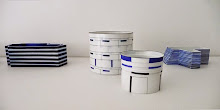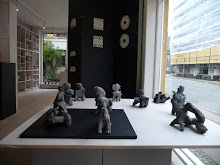


Click IMAGE =
LARGE FORMAT
and slide show
GRAPHIC TALES
Lisbeth Holst-Jensen DK
Exhibition 2 – 26 maj 2012








A ceramic composition of graphic images in interaction with oval forms.
The exhibition is a fine example of how skills, technical ingenuity, artistic and musical understanding can combine in the ceramic media.




The graphic vessels and 'image-plates' reflect Lisbeth Holst-Jensen's experience with the tactile possibilities of the ceramic material, knowledge of art history and artistic curiosity linked to a great passion for music.
 Lisbeth Holst-Jensen was educated at the Kunsthåndværkerskole (Denmarks DesignSchool) in Copenhagen and has an Eksam.Art (BA) in Art History at the Copenhagen University.
Lisbeth Holst-Jensen was educated at the Kunsthåndværkerskole (Denmarks DesignSchool) in Copenhagen and has an Eksam.Art (BA) in Art History at the Copenhagen University. She taught at the Skolen For Brugskunst (Denmarks DesignSchool) for a number of years and is especially renowned for her knowledge of art history, decoration and material understanding, and a indomitable passion for working with ceramics from her first functional ware to the latest graphic and imagery motives on ceramic form and surface.
She has received grants and awards from The National Danish Art Foundation, The National Bank Art Foundation and has exhibited at the Denmark Ceramic Museum 2007, Georg Jensen 2004, Gallery Nørby 2001, Bornholm Museum 1999, and sold pieces to the Danish colletions: Statens Kunstfond (National Art Foundation), Art Museum Trapholt, New Carlsberg Foundation etc.




GRAPHIC TALES by Lisbeth Holst-Jensen www.lisbethholst-jensen.dk
The surface of the oval forms is characterised by the content told in a graphic language, where the division between dark and light parts creates the basic structure, while the ceramic materials give to the expression a high degree of depth and tactile character. In the simplified motives and lines, the image-surface shows the expression and tension, that appear between them. The desire is, in an abstract graphic form language, to express an atmosphere, a tale.
 Subject wise I become occupied with a detail, a structure, that I 'spread' and allow to set the agenda for the whole composition. I draw or paint the themes again and again, finding a simplification and abstraction, that makes the motive ambiguous and open for interpretation.
Subject wise I become occupied with a detail, a structure, that I 'spread' and allow to set the agenda for the whole composition. I draw or paint the themes again and again, finding a simplification and abstraction, that makes the motive ambiguous and open for interpretation.The motives are built up on a flat piece of cloth, where layer upon layer of the soft porcelain are dripped, poured, brushed. The thickness defines to what extent the next layer will 'shine through'. The thin 'clay-image' is transferred to a clay-slab, and then it is formed. This working method, I have developed, gives me room for improvisation and impulsion, and results in a richness of nuances, that awaken the image expression. The result often holds an area of tension, tells a story.
The painted tiles appeared from my wish to work with surfaces on a large scale. The individual clay-sheets can, as a module, join to larger units. This gives me a larger work space, contain more 'material' and more statements. This desire is a natural consequence of the very concentrated expression on the oval vessels.
I have developed my image-technique, that is now transferred to a ceramic sheet, that will keep a straight form and surface after firing. The sheets can be seen as individual images with a thematic connection or a unified composition. This use of clay-sheets may lead into new possibilities for commission work.
BIOGRAPHY – Lisbeth Holst-Jensen CV
 Lisbeth Holst-Jensen grew up on the Danish island of Bornholm, as a next door neighbor to the oldest stoneware factory in the North: Hjorths Fabrik, where she in her childhood collected rejected bisque ware, that she painted on. At the age of 15 she started making her own ceramics fired at the factory. This place was for her like an 'Aladdins Cave' and has highly influenced her first years in ceramics.
Lisbeth Holst-Jensen grew up on the Danish island of Bornholm, as a next door neighbor to the oldest stoneware factory in the North: Hjorths Fabrik, where she in her childhood collected rejected bisque ware, that she painted on. At the age of 15 she started making her own ceramics fired at the factory. This place was for her like an 'Aladdins Cave' and has highly influenced her first years in ceramics.Inspiration came generally from the fertile ceramic environment at Bornholm: Lisbeth Munch Petersen, Gertrud Vasegård, Marie Hjorth, Grethe Lindblad, Julie Høm, Bo Christiansen, Hans Munch Andersen and Gert Hjorth Petersen, - and many others; - together with ”the unique nature of Bornholm, the great variation of landscape, plants and growth, the Baltic sea and the cliffs”.
At the age of 18 Lisbeth started at the Art School, 'Kunsthåndværkerskolen' in Copenhagen. – She says: ”It was a revelation being permitted to work with my greatest interest, the creative – every day. I had Niels Lauesen as a teacher for all the 5 years, and I am grateful for it. During a School trip to London in 1974, visiting Tate Gallery, it was an especially fine experience seeing an exhibition of the painter Mark Rothko.”
When Lisbeth Holst-Jensen studied Art History at the Copenhagen University (1975-79) her main areas were the painters Max Ernst and Jackson Pollock, and Middle-age frescoes in Denmark and Italy. - ”The lectures about fine art, sculpture and architecture opened a new world – a treasure chamber of expression possibilities, that formed a foundation for the rest of my working life”.
The awarded residencies at the Danish National Studios for Arts and Crafts in Copenhagen (1998, 2001) and the Danish Art Institution San Cataldo in Italy (2002, 2008) offered optimal work conditions and artistic development. Journeys and exhibitions, mainly in Europe, have given active time for studying collections and special exhibitions of major artists, like the latest Kandinsky-exhibition at Centre Pompidou in Paris. Likewise a scholarship journey to New York was of great inspiration, - ”and naturally colleagues work and exhibitions in Denmark”.

















































































































